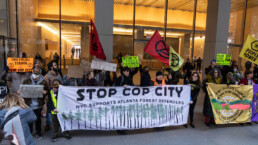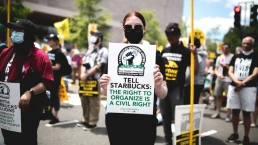Georgia’s sweeping and political application of conspiracy law echoes a tactic that shattered the left roughly a hundred years ago, when the U.S. government targeted socialist parties and militant unions with laws against criminal syndicalism, espionage, and sedition.
By Tadhg Larabee and Eva Rosenfeld, Dissent
Just after sunrise on November 13, 2023, hundreds of protesters gathered in Gresham Park on Atlanta’s outskirts. As they zipped up painted jumpsuits, a police helicopter circled overhead. It was the start of the latest action in a sprawling, decentralized campaign to stop construction of the Atlanta Public Safety Training Center, better known as Cop City.
A two-year occupation of the Weelaunee Forest, the site of the proposed complex, ended in early 2023 after police killed a forest defender known as Tortuguita and, over several months, charged forty-two people with domestic terrorism. The majority of those charged were attending a protest music festival in March while property destruction occurred nearly a mile away. In April, three activists distributing fliers about the police murder of Tortuguita were arrested and jailed for almost three months. It was unclear whether any of the prosecutions would go forward until September, when Georgia’s attorney general, Chris Carr, brought a single case against sixty-one protesters, using the state’s exceptionally broad Racketeer Influenced and Corrupt Organizations (RICO) Act to paint the Stop Cop City movement as a criminal syndicate akin to the Mafia. The sprawling indictment accused them of a conspiracy to spread “virulent anarchist ideals.”

Amid this campaign of state repression, one segment of Stop Cop City put out a national call to action: Meet in Atlanta. March onto the construction site. Issue, through nonviolent direct action, what organizers called a “people’s stop-work order.” Render absurd, through widely publicized mass participation, the notion that this is a conspiracy and not a broad-based political movement.
“It’s vital to make sure everybody knows . . . that there are people in Atlanta that want this to stop,” said Lorraine Fontana, a seventy-six-year-old activist who was arrested days before the march for blocking the entrance to the construction site. “We’re holding saplings,” a young protester said. “To replant the forest that the police have destroyed in trying to build Cop City,” another added. Papier-mâché puppets and protest signs sat in the grass, collecting dew; one sign, shaped like a dragonfly, read, “This is what a domestic terrorist looks like.” Hours later, as the tear gas dissipated and the protesters retreated to Gresham Park, a riot policeman was photographed removing the same sign from nearby Constitution Road. In the hands of the officer, it seemed to turn this charge back on the state.
Recent Posts
We’ve Reached The Medicare For All Tipping Point
December 7, 2025
Take Action Now With the health care crisis spiraling out of control, a pivotal majority of Americans now support a single-payer system.By David…
Zohran Mamdani & Bernie Sanders Join Striking Starbucks Workers
December 6, 2025
Take Action Now ‘This is a union town.’ Zohran and Bernie join the Starbucks picket line to demand the coffee giant reach a fair contract…
Canadian Liberals Fear Closing Arms Export Loophole Would Anger U.S.
December 5, 2025
Take Action Now A leaked briefing document gives the full picture behind the government’s talking points.By Alex Cosh, The Maple A leaked Liberal…
Video of U.S. Military Killing Boat Strike Survivors Is Horrifying, Lawmakers Reveal
December 5, 2025
Take Action Now “What I saw in that room is one of the most troubling scenes I’ve ever seen in my time in public service.”By Nick Turse, The…




